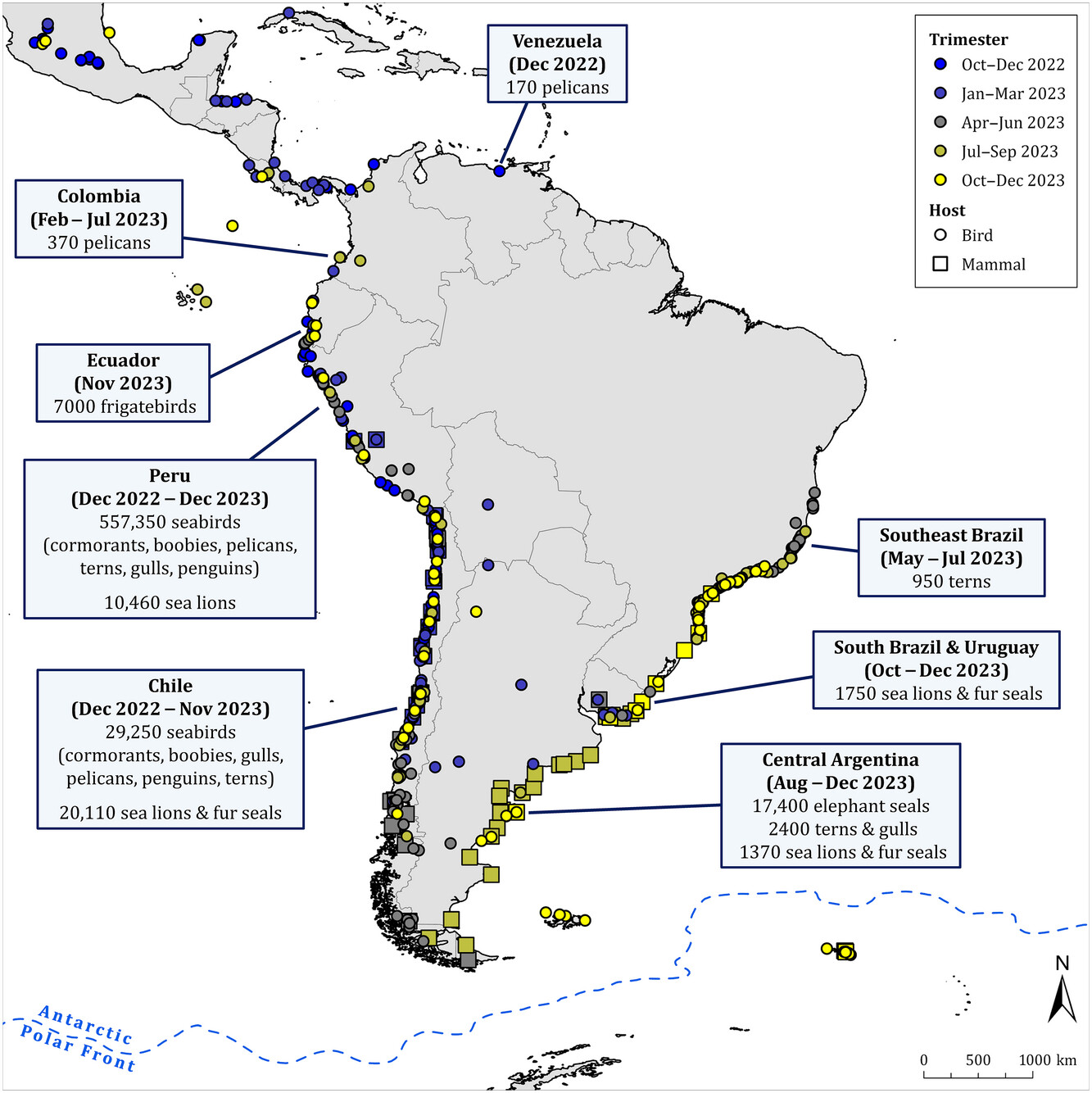
Locations of reported mortalities associated with high-pathogenicity avian influenza virus of the subtype H5 in wild birds and wild mammals in Central America, South America, and neighbouring island groups (from the publication)
World Albatross Day 2025 with its theme of “Effects of Disease” falls on 19 June. From today until the 19th ACAP Latest News intends to post daily articles during “WADWEEK” that address or refer to the theme.
Thijs Kuiken (Department of Viroscience, Erasmus University Medical Centre, Rotterdam, The Netherlands) and colleagues have reviewed the occurrence and spread of high-pathogenicity avian influenza in South America and in Antarctica and the Southern Ocean open access in the journal Conservation Biology.
The paper’s abstract follows:
“The currently circulating high-pathogenicity avian influenza (HPAI) virus of the subtype H5 causes variable illness and death in wild and domestic birds and mammals, as well as in humans. This virus evolved from the Goose/Guangdong lineage of the HPAI H5 virus, which emerged in commercial poultry in China in 1996, spilled over into wild birds, and spread through Asia, Europe, Africa, and North America by 2021. Our objective was to summarize the spread and impact of the HPAI H5 virus in wild birds and mammals in South America, evaluate the risk of its spread and potential impact on Antarctic wildlife, and consider actions to manage the current and future HPAI outbreaks in wildlife. We obtained data on HPAI H5 virus detection and reported wildlife deaths from websites, newspaper articles, and scientific publications. The virus arrived in South America in October 2022. Thereafter, it spread widely and rapidly throughout the continent, where it infected at least 83 wild bird species and 11 wild mammal species and is estimated to have killed at least 667,000 wild birds and 52,000 wild mammals. The HPAI H5 virus spread to the Antarctic region by October 2023 and to mainland Antarctica by December 2023. This spread was associated with multiple mortality events in seabirds and marine mammals. The high spatial density of colonies of various Antarctic species of birds and mammals provides conditions for potentially devastating outbreaks with severe conservation implications. Ecosystem-level impacts may follow, and affected populations may take decades to recover. Although little can be done to stop the virus spread in wildlife, it is important to continue targeted surveillance of wildlife populations for HPAI H5 virus incursion and assessment of the spread and impact of disease to inform adaptation of conservation plans and to help policy makers mitigate and prevent future HPAI outbreaks.”
With thanks to Patricia Serafin, ACAP Intersessional Group on Avian Influenza and Diseases.
Reference:
Kuiken, T., Vanstreels, R.E.T., Banyard, A., Begeman, L., Breed, A., Dewar, M., Fijn, R., Serafini, P.P., Uhart, M. & Wille, M. 2025. Emergence, spread, and impact of high pathogenicity avian influenza H5 in wild birds and mammals of South America and Antarctica, October 2022 to March 2024. Conservation Biology doi.org/10.1111/cobi.70052.
John Cooper, Emeritus Information Officer, Agreement on the Conservation of Albatrosses and Petrels. 13 June 2025

 English
English  Français
Français  Español
Español